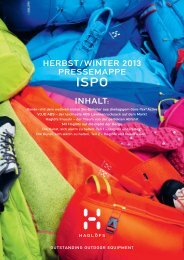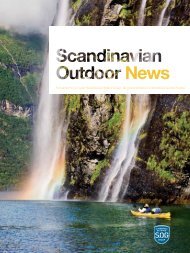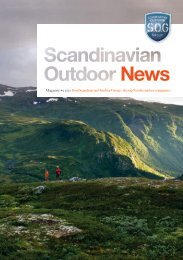News - Scandinavian Outdoor Group
News - Scandinavian Outdoor Group
News - Scandinavian Outdoor Group
Create successful ePaper yourself
Turn your PDF publications into a flip-book with our unique Google optimized e-Paper software.
Business R & D<br />
Knitted<br />
in Sweden<br />
The FirsT säTila BeaNies were knitted back<br />
in 1896. Later on, Ingemar Stenmark wore one.<br />
Today, the Swedish Skicross team keeps their<br />
heads warm with these knitted wool hats from<br />
the small town in western Sweden.<br />
The Swedish company Sätila became<br />
world famous when skier Ingemar Stenmark<br />
outperformed the world’s top skiers in slalom<br />
and giant slalom in the 70’s and 80’s.<br />
On his head he wore a cap designed by his<br />
mother Gunborg and knitted by Sätila. It became<br />
a symbol for the Swedish champion, and<br />
Sätila ramped up production and started growing fast.<br />
”Today we sell our caps in 15 different countries,”<br />
says Lotta Persson, brand manager at Sätila of Sweden.<br />
”We have designed more than 100 models for skiers,<br />
climbers, multi-sport athletes, snowboard riders and for<br />
everyday life in the city.”<br />
A lot has changed since the company’s founder<br />
Johannes Nilsson opened his first small-scale factory in<br />
A beautiful friendship<br />
siNce Their sTarT almost 20<br />
years ago, Houdini Sportswear,<br />
Sweden, has been developing<br />
clothing in close cooperation with a<br />
small group of Houdini Friends. Eva<br />
Karlsson, CEO and head of Product<br />
Development, tells why Houdini has<br />
chosen to work with people like<br />
Swedish UIAGM-authorized mountain<br />
guide Carl Lundberg.<br />
“We have always been innovative<br />
when it comes to product development.<br />
We spend years testing new<br />
materials and products before a garment<br />
is ready to be used by enthusiasts<br />
in the mountains all over the<br />
world. When we launch a new product,<br />
it’s because our Houdini Friends<br />
or ourselves have discovered that<br />
what exists on the market isn’t good<br />
enough for our needs – both the<br />
needs for technical performance, as<br />
well as for sustainability,” says Eva<br />
Karlsson and continues:<br />
“Houdini Friends like Carl<br />
Lundberg have been with us since<br />
the very start. With Carl’s vast<br />
experience in the mountains, we get<br />
invaluable input. This way, we can<br />
be sure of the performance detailing<br />
each garment.”<br />
TogeTher WiTh The FrieNds<br />
and supplier’s R&D departments,<br />
Houdini has been able to produce<br />
several new technical and durable<br />
materials that also are sustainable.<br />
More than 80 percent of Houdini’s<br />
range is made from renewable or<br />
recycled fiber, and an even greater<br />
percentage is fully biodegradable or<br />
recyclable.<br />
“To work hard, play hard, have<br />
fun and create the best products,<br />
while at the same time reducing<br />
our environmental footprint, is what<br />
we’re all about at Houdini,” summarizes<br />
Eva Karlsson.<br />
Sätila made the cap that Ingemar Stenmark wore when<br />
he out skied Phil Mahre, Bojan Krizaj and Pierro Gros in<br />
the 70’s and 80’s. Now skicross-ace Anna Holmlund,<br />
World Cup-winner 2010/11, and top skicross-skier Micke<br />
Forslund are winning fresh victories in new Sätila hats.<br />
the town of Sätila in 1910 and since Gunborg Stenmark<br />
started designing her legendary patterns. However, one<br />
thing hasn’t changed: all Sätila-hats are still knitted in<br />
Sweden.<br />
”We take pride in the fact that we’re still Made in<br />
Sweden,” says Persson.<br />
vatnajökull in<br />
merciless weather<br />
it was a hard and dangerous trip, but<br />
the three italians really wanted to cross<br />
vatnajökul l in the middle of the winter.<br />
leiFur orN svavarssoN, a mountain guide and<br />
instructor for the Icelandic Search and Rescue teams,<br />
ICE-SAR, guided the group up the glacier – one of the<br />
largest ice caps in Europ e – in temperatures below -20<br />
°C, with strong winds and limited visibility.<br />
At their first stop they found a cabin that had been<br />
transformed into an ice block. Svavarsson and the others<br />
had to use their ice axes and hack themselves inside.<br />
Then, they spent several days in tents – and one night<br />
in a crevasse – during blizzards and chilling temperatures<br />
before they crossed just below Iceland’s highest peak,<br />
Hvannadalshnúkur (2,109 meters) and down to the south<br />
side of Vatnajökull.<br />
To puT up WiTh the exceptional weather conditions that<br />
the team faced, Svavarsson had to use all of his skills<br />
and experience from almost 30 years as a mountain<br />
guide, as well as a dozen years as a member of the<br />
Search and Rescue team.<br />
At the ISPO Fair, mountain<br />
guide Leifur Orn Svavarsson<br />
will tell you more about how<br />
he uses his experience from<br />
blizzards, avalanches and<br />
gales to help 66°NORTH create<br />
better clothing.<br />
“I’ve always been drawn to the most remote areas<br />
and the hardest conditions – this time I got plenty of it,”<br />
says Svavarsson.<br />
One of the biggest problems during the trip was that<br />
the merciless cold was accompanied by high humidity.<br />
Svavarsson’s shell jacket would freeze like a statue.<br />
He had to leave it standing by the tent door at night, so it<br />
would thaw just enough so that he could wrangle it on in<br />
the morning.<br />
TodaY, svavarssoN TraiNs the ICE-SAR in survival<br />
skills and technical climbing. To get the right work<br />
wear he has been helping Icelandic outdoor company<br />
66°NORTH with the testing of new shells, fleece garments<br />
and woolen products.<br />
Since the trip with the Italians two years ago, he has<br />
also helped Polartec with material testing.<br />
One of the results of this cooperation is the Snæfell<br />
Jacket, made from Polartec Neoshell, which is a new<br />
fabric that has the durability and stretch of a polyurethane<br />
film, plus the breathability of a micro porous<br />
structure.<br />
“The breathability of the Snæfell jacket would have<br />
made life a lot easier on the trip across Vatnajökull,” says<br />
Svavarsson.<br />
8 ScaNdiNaviaN OutdOOr NewS<br />
ScaNdiNaviaN OutdOOr NewS 9







